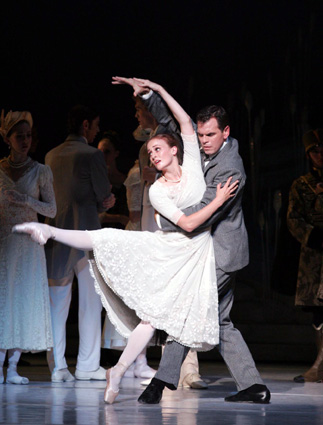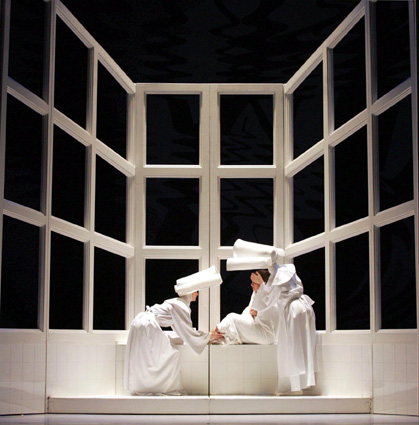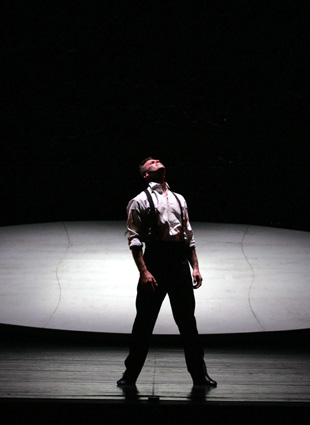“Swan
Lake”
Australian Ballet
Wales Millenium Centre / London Coliseum
July 13 – 24,
2005
by
John Percival
copyright
©2005 by John Percival
Graeme
Murphy’s “Swan Lake” for the Australian Ballet has just
completed the company’s first visit to Britain in well over a decade,
performing in the new Wales Millenium Centre, Cardiff (lovely big stage,
good acoustics) and the more familiar London Coliseum. Wildly enthusiastic
audiences, mixed reviews (but what do you expect from some of our idiot
critics?). This is a very different show from the “Swan Lake”
that filled the company’s first night on its foundation in 1962.
That one was produced by its English first director, Peggy van Praagh,
modelled on what she had known in London and starring international guest
artists Sonia Arova and Erik Bruhn, almost direct from Covent Garden.
Thereafter the ballet was never long out of the Australian repertoire
in one version or another, and when leading dancer David McAllister was
persuaded four years ago to quit the stage and become artistic director
in succession to Ross Stretton, one of his first decisions was to commission
a new “Swan Lake” to celebrate the company’s fortieth
anniversary. But this was to be one that needed no guest stars and was
entirely created by Australian artists.
 To
stage it, McAllister turned to the man who is incontestably Australia’s
best choreographer, Graeme Murphy. Beginning his dance career in the Australian
Ballet, Murphy progressed as far as playing Puck in Ashton’s “The
Dream”, but always wanted to become a choreographer. Deciding this
would not happen without wider experience, he studied further at the Joffrey
School in New York and danced in Europe with Sadler’s Wells Royal
Ballet and the Grenoble-based Ballets de Félix Blaska. But by age
25, in 1976, he was back in Australia and making ballets for various small
companies. These were good enough for the Dance Company of New South Wales
to appoint him artistic director—a post in which he has triumphed
ever since.
To
stage it, McAllister turned to the man who is incontestably Australia’s
best choreographer, Graeme Murphy. Beginning his dance career in the Australian
Ballet, Murphy progressed as far as playing Puck in Ashton’s “The
Dream”, but always wanted to become a choreographer. Deciding this
would not happen without wider experience, he studied further at the Joffrey
School in New York and danced in Europe with Sadler’s Wells Royal
Ballet and the Grenoble-based Ballets de Félix Blaska. But by age
25, in 1976, he was back in Australia and making ballets for various small
companies. These were good enough for the Dance Company of New South Wales
to appoint him artistic director—a post in which he has triumphed
ever since.
Apart from the international successes of his own company, soon renamed Sydney Dance Company, for whom he has mounted a cavalcade of specially created works, Murphy has directed operas, done an ice show, and made dances for many other ballet companies, including several for the Australian Ballet. Notable among these was a "Nutcracker" which adapted the plot to illustrate the history of dance from Russian days right through to its present Australian manifestation. So what kind of a "Swan Lake" could be expected from him?
As always, he prepared it in collaboration with his long-term partner Janet Vernon, and they worked together with another frequent colleague, the designer Kristian Fredrikson (New Zealand born but settled in Australia for more than forty years). What Murphy eventually suggested to McAllister after long and involved discussions was a “Swan Lake” about a Prince who marries an innocent young girl, Odette, but maintains the connection with his mistress, Baroness von Rothbart. Well, the inspiration from events in the British royal family—with Prince Charles, his two successive wives and what Diana famously described as “three of us in that marriage”—was obviously going to be a selling point, but the ballet does not literally follow the real-life situation. Rather it is a story about credible people in a tragic situation that ends badly for all of them.
The ballet starts with a brief prologue before the wedding, set to the overture: Odette is alone, looking apprehensive; when she disappears behind a black curtain, Siegfried, bare-chested, produces the Baroness from behind the same curtain and sinks on to a bed with her.
 Act
1 is the wedding celebration and begins cheerfully enough: lots of animated
ensembles (Fredrikson provides uniforms and smart civilian clothes from
the 20th century, exact date left a bit free), many photographs posed
and taken. The baroness (complete with husband and children, but they
soon disappear) provides an entertainment to the Hungarian dance from
Act 3—mostly Murphy follows the rarely heard running order that
Tchaikovsky intended. But things begin going wrong for Odette. Her new
husband responds too willingly to the Baroness’s attentiveness.
The Queen is cool to her, warmer to the rival. Is it surprising that she
goes odd, flirting with lots of men (that really does come from Princess
Di, but later), even kicking Siegfried in the chest. With Royal approval,
she is examined by a doctor and led away to a madhouse; everyone leaves
except the smugly naughty loving couple.
Act
1 is the wedding celebration and begins cheerfully enough: lots of animated
ensembles (Fredrikson provides uniforms and smart civilian clothes from
the 20th century, exact date left a bit free), many photographs posed
and taken. The baroness (complete with husband and children, but they
soon disappear) provides an entertainment to the Hungarian dance from
Act 3—mostly Murphy follows the rarely heard running order that
Tchaikovsky intended. But things begin going wrong for Odette. Her new
husband responds too willingly to the Baroness’s attentiveness.
The Queen is cool to her, warmer to the rival. Is it surprising that she
goes odd, flirting with lots of men (that really does come from Princess
Di, but later), even kicking Siegfried in the chest. With Royal approval,
she is examined by a doctor and led away to a madhouse; everyone leaves
except the smugly naughty loving couple.
Act 2: the nuns who run the madhouse look, in their white habits and headdresses, a little like swans, and now Odette imagines herself on a lake of swans whose serenity is consoling. She even dreams that Siegfried returns to dance with her as a swan.
Act 3: the Baroness is giving a party in her dark, grand house. The Prince is so much at home that he removes his dinner jacket (nobody else does). But suddenly Odette appears, elegant and calm in white. Siegfried falls for her again. The Baroness, furious, sends for the mental doctor, but Odette disappears. The scene changes to the lake, where Siegfried finds Odette in her wedding dress—but under it she wears her swan costume, but black now, and so are the other swans. Briefly it seems they might be happy together. The Baroness arrives but is sent packing. However, Odette realises her future is with the swans, and the Prince is left finally alone.
 The
emotional impact comes largely from a series of solos, duets and trios
for the principals, often melancholic but both women have really fierce
moments. The ballet was built around the performance of long-time leading
man Stephen Heathcote as the Prince; he is 40 now, not so slim as he was
but still very supple and with a royal air. Sharing the role were the
good-looking Robert Curran and a slightly disappointing Damien Welch (son
of original company stars Marilyn Jones and Garth Welch). Murphy chose
young soloists to play the women, and the three casts shown here were
all able enough; Madeleine Eastoe and Lynette Wills on opening night,
followed by Rachel Rawlins and Olivia Bell. Outstanding, however, were
Elisha Willis, returning as guest from her present engagement with Birmingham
Royal Ballet to play a truly touching Odette, and Lucinda Dunn as a smilingly
lascivious Baroness. At the other extreme, however, I must mention (among
several old-timers in mime roles) the presence, still on stage, of Colin
Peasley, who appeared as a peasant boy and a czardas dancer in the company’s
very first performance 43 years ago and now appears as an admiral, who
may remind us of the late Lord Mountbatten. Clearly the company under
McAllister retains its gift for looking both forward and back, getting
the best of both worlds. His only regret about the present visit is that
with such a big production it isn’t practicable to bring a wider
repertoire, but it will be surprising, and very sad, if they don’t
find a way to return a bit sooner this time.
The
emotional impact comes largely from a series of solos, duets and trios
for the principals, often melancholic but both women have really fierce
moments. The ballet was built around the performance of long-time leading
man Stephen Heathcote as the Prince; he is 40 now, not so slim as he was
but still very supple and with a royal air. Sharing the role were the
good-looking Robert Curran and a slightly disappointing Damien Welch (son
of original company stars Marilyn Jones and Garth Welch). Murphy chose
young soloists to play the women, and the three casts shown here were
all able enough; Madeleine Eastoe and Lynette Wills on opening night,
followed by Rachel Rawlins and Olivia Bell. Outstanding, however, were
Elisha Willis, returning as guest from her present engagement with Birmingham
Royal Ballet to play a truly touching Odette, and Lucinda Dunn as a smilingly
lascivious Baroness. At the other extreme, however, I must mention (among
several old-timers in mime roles) the presence, still on stage, of Colin
Peasley, who appeared as a peasant boy and a czardas dancer in the company’s
very first performance 43 years ago and now appears as an admiral, who
may remind us of the late Lord Mountbatten. Clearly the company under
McAllister retains its gift for looking both forward and back, getting
the best of both worlds. His only regret about the present visit is that
with such a big production it isn’t practicable to bring a wider
repertoire, but it will be surprising, and very sad, if they don’t
find a way to return a bit sooner this time.
Photos, of Stephen
Heathcote (Prince Siegfried), Madeleine Eastoe (Odette) and Lynette Wills
(Baroness von Rothbart) in Graeme Murphy's "Swan Lake," are
by David Kelly.
Volume 3,
No. 28
July 25, 2005
copyright
©2005
John Percival
www.danceviewtimes.com
|
|